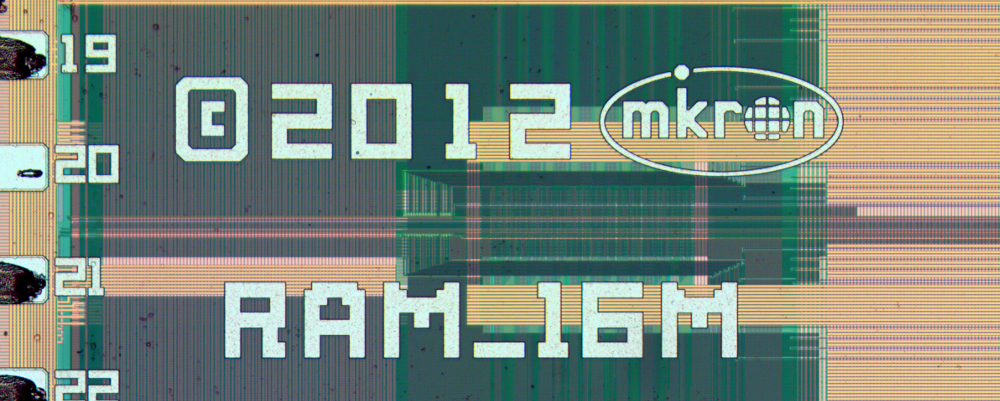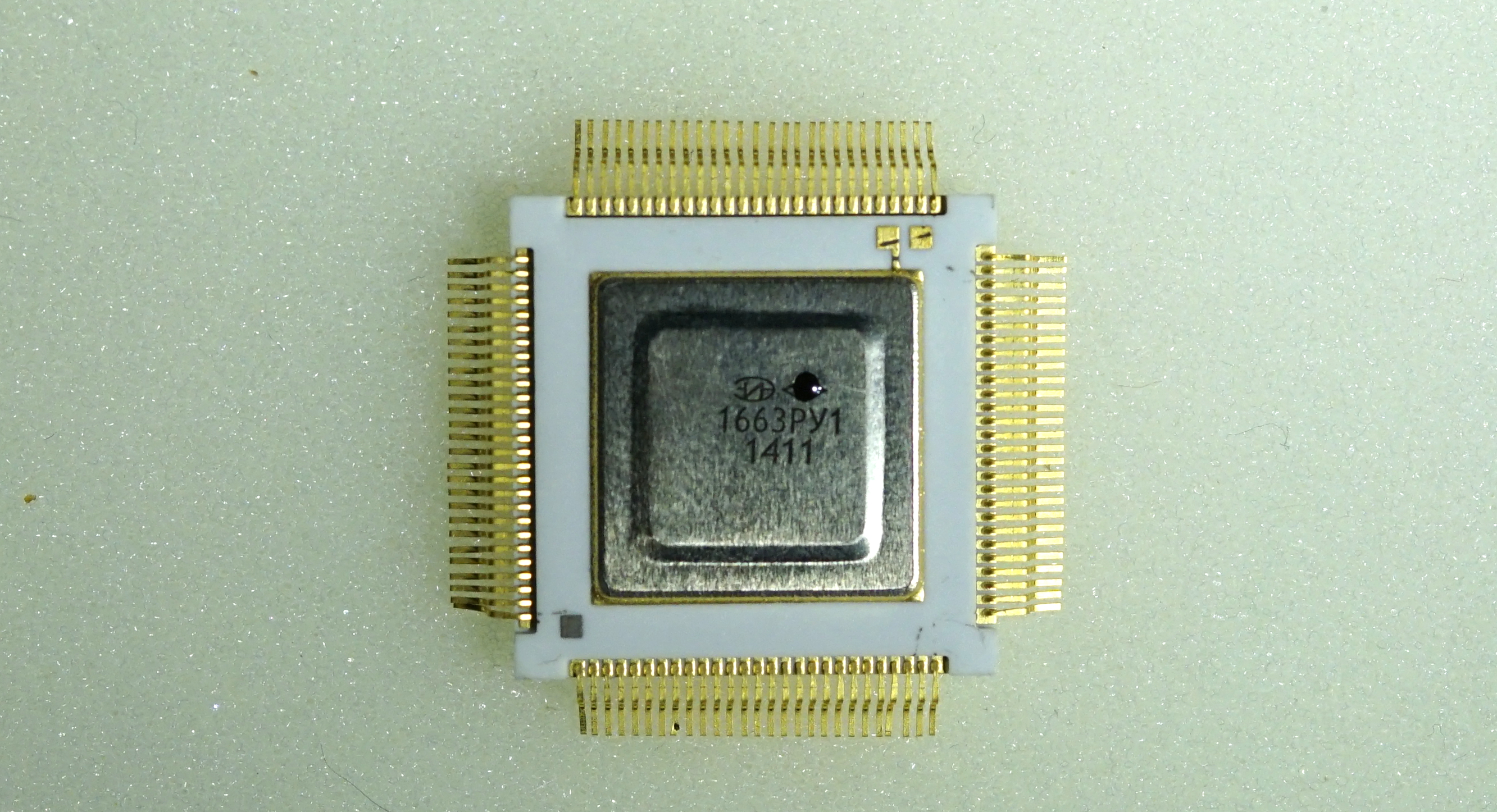The first 90nm product from Micron under the microscope - 16 Mibit SRAM
There are a lot of loud statements around Micron on the Runet’s expanses - but they are not often checked in practice. What is it, 90nm from Micron? Thanks to an anonymous reader, it was possible to obtain a sample of a 90nm chip made on Micron - 1663RU1, 16Mbps of static memory. I will not torment - 90nm is still there!


')
Top view, rarely have to see numbered legs right on the crystal:

To get to the memory itself - you need to remove the metallization (by 90nm - already copper, also a big step forward compared to aluminum by 180nm). At one time, at specialized conferences they did not believe that copper would be introduced on Micron (without it, performance and reliability are significantly lower) - but the pessimists were confounded. Looking ahead - in each of the "squares" - a matrix of 64x128 bits, a total of 16 megabits for the entire crystal.

Finally, the memory cells themselves. The cell area is 1.2 μm 2 , which corresponds to the average level of technology at 90 nm (the best ones are about 1 μm 2 ). At first, it was embarrassing that the minimum half-step in the control transistors is 180nm, but in the STM32 it is also significantly more than the norms of the memory itself. 90nm in memory cells honest. Scale: 1px = 57nm.

For comparison, SRAM from ST Microelectronics (from STM32F100C4T6B ) at 180nm on the same scale. The cells are just horse.

If you take a piece where a little of the first metal remains, you can clearly see that Micron uses a more modern version of static memory optimized for photolithography, where only straight lines are used on critical layers. It's nice that they didn’t formally approach 90nm, scaling a tried-and-true, classic implementation.

Andrew Zonenberg explains how the 6T SRAM memory cell is located here:

Thus, we can congratulate Micron on reaching an important milestone in a real product, and not on paper. This is no longer a transistor in a cube. Of course, it hardly worked in 2012, but 2013/2014 can definitely be marked in the calendar as the year when 90nm production in Russia worked.
When (if) Angstrem-T starts working - it will be only the second on this celebration of life with its version of 90nm from IBM (and 130nm from AMD). Well, honest 65nm in a real product we will probably have to wait another year or two.
Ps. Yes, the standard comment “Intel has 14nm, and here the ancient 90nm” is not worth writing - the overwhelming number of chips in the world is 180nm and thicker. In my blozhike even 180 nm microcircuit rarity, 250-350nm and thicker most often. Microelectronics is not only central processors.


')
Top view, rarely have to see numbered legs right on the crystal:

To get to the memory itself - you need to remove the metallization (by 90nm - already copper, also a big step forward compared to aluminum by 180nm). At one time, at specialized conferences they did not believe that copper would be introduced on Micron (without it, performance and reliability are significantly lower) - but the pessimists were confounded. Looking ahead - in each of the "squares" - a matrix of 64x128 bits, a total of 16 megabits for the entire crystal.

Finally, the memory cells themselves. The cell area is 1.2 μm 2 , which corresponds to the average level of technology at 90 nm (the best ones are about 1 μm 2 ). At first, it was embarrassing that the minimum half-step in the control transistors is 180nm, but in the STM32 it is also significantly more than the norms of the memory itself. 90nm in memory cells honest. Scale: 1px = 57nm.

For comparison, SRAM from ST Microelectronics (from STM32F100C4T6B ) at 180nm on the same scale. The cells are just horse.

If you take a piece where a little of the first metal remains, you can clearly see that Micron uses a more modern version of static memory optimized for photolithography, where only straight lines are used on critical layers. It's nice that they didn’t formally approach 90nm, scaling a tried-and-true, classic implementation.

Andrew Zonenberg explains how the 6T SRAM memory cell is located here:

Thus, we can congratulate Micron on reaching an important milestone in a real product, and not on paper. This is no longer a transistor in a cube. Of course, it hardly worked in 2012, but 2013/2014 can definitely be marked in the calendar as the year when 90nm production in Russia worked.
When (if) Angstrem-T starts working - it will be only the second on this celebration of life with its version of 90nm from IBM (and 130nm from AMD). Well, honest 65nm in a real product we will probably have to wait another year or two.
Ps. Yes, the standard comment “Intel has 14nm, and here the ancient 90nm” is not worth writing - the overwhelming number of chips in the world is 180nm and thicker. In my blozhike even 180 nm microcircuit rarity, 250-350nm and thicker most often. Microelectronics is not only central processors.
Source: https://habr.com/ru/post/262255/
All Articles